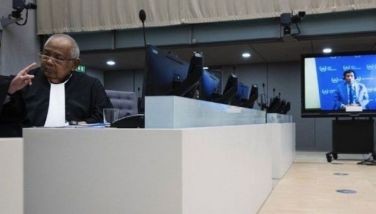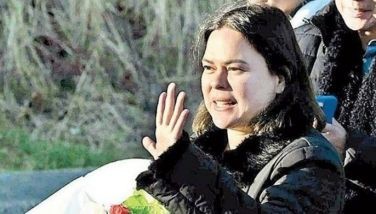Phil-Austrian concert
January 15, 2003 | 12:00am
Never has this reviewer heard the "Laughing Song" from the Die Fledermaus rendered with more panache than when Rachelle Gerodias sang it at last week’s Phil-Austrian concert in the CCP auditorium under the baton of Austrian guest conductor Ernest Hoetzl.
The soprano charmed listeners with the wildest gamut of nuances, as also with eloquent yet restrained gestures and expressive artistry that lit up her pretty face. She would sing pianissimo then slowly and steadily increase her volume, sustaining the high notes with a power incredible for so petite a singer. Her tour de force would have enthralled the most discriminating cognoscenti.
In fact, the "Laughing Song", the evening’s centerpiece to my mind, was only one of the vocal highlights. With similarly impeccable diction, smooth legatos and admirable portamento, she likewise sang Estella’s Ang Maya, and duets with tenor Nolyn Cabahug.
Like Gerodias, Cabahug was in fine vocal form, his timber even, his tones resonant and full-bodied in all registers. His top notes were particularly impressive in his solos Dein ist mein ganzes Herz (Yours Is My Heart Alone) by Lehar, in the light-hearted Ako’y Hindi Duwag from Tolentino’s zarzuela Walang Sugat, as well as in the duets – the comic "Makikiliti Kang Totoo"(You’ll Be Tickled Pink), and "Bayan Ko", also from Walang Sugat.
Although Cabahug did not convey as wide a range of nuances and subtle expression – vocally, artistically or theatrically as Gerodias did – the listeners tingled with excitement each time he went sailing off the high C’s and beyond.
One can imagine the immense "double" delight Gerodias and Cabahug brought in the duets, having already enthralled the audience in their respective solos. Listeners were by now enraptured by the stirring climax "Bayan Ko", earlier described as "our second national anthem".
No nationalistic or patriotic Filipino can listen to that song, especially when rendered with such profound feeling by Gerodias and Cabahug, and not be moved to the depths of his being while he grieves over his benighted, oppressed and beleaguered bayan.
This reviewer is not aware of any rule that requires a conductor, in this instance visiting Austrian Ernest Hoetzl, to hold back in the final tutti passages in deference to the singers who must encounter a daunting challenge as they rise above the thunderous orchestral volume. Fortunately, in this regard, Gerodias and Cabahug held their own through the last fortissimo note.
Oddly enough, Dr. Hoetzl did not seem at his best that night (owing to jet lag?) although he was interpreting his very own native music – selections by Strauss, Jr., Lehar, Lanner, Stolz, Hellmesberger and Humperdinck (Prelude to Hanzel and Gretel), all of which are presumably familiar to him and dear to his hearing.
The vapid rendition of our national anthem appeared to have presaged the over-all quality of the orchestral interpretations which were generally wanting in brilliance and brio, exceptions granted; e.g., Stolz’s brisk, breezy, rousing Viennese Coffee Waltz. Further, the PPO conveyed fiery spirit and vigor in the zarzuela excerpts, particularly in the finale, Bayan Ko.
Describing this work to the audience as the Philippines second national anthem, Dr. Hoetzl counter-balanced it with The Beautiful Blue Danube, prefacing his rendition with the amusing observations that it is his own country’s second national anthem.
The familiar, widely-loved waltz thus ended the entertaining, resoundingly applauded Phil-Austrian concert with a Viennese lilt.
The soprano charmed listeners with the wildest gamut of nuances, as also with eloquent yet restrained gestures and expressive artistry that lit up her pretty face. She would sing pianissimo then slowly and steadily increase her volume, sustaining the high notes with a power incredible for so petite a singer. Her tour de force would have enthralled the most discriminating cognoscenti.
In fact, the "Laughing Song", the evening’s centerpiece to my mind, was only one of the vocal highlights. With similarly impeccable diction, smooth legatos and admirable portamento, she likewise sang Estella’s Ang Maya, and duets with tenor Nolyn Cabahug.
Like Gerodias, Cabahug was in fine vocal form, his timber even, his tones resonant and full-bodied in all registers. His top notes were particularly impressive in his solos Dein ist mein ganzes Herz (Yours Is My Heart Alone) by Lehar, in the light-hearted Ako’y Hindi Duwag from Tolentino’s zarzuela Walang Sugat, as well as in the duets – the comic "Makikiliti Kang Totoo"(You’ll Be Tickled Pink), and "Bayan Ko", also from Walang Sugat.
Although Cabahug did not convey as wide a range of nuances and subtle expression – vocally, artistically or theatrically as Gerodias did – the listeners tingled with excitement each time he went sailing off the high C’s and beyond.
One can imagine the immense "double" delight Gerodias and Cabahug brought in the duets, having already enthralled the audience in their respective solos. Listeners were by now enraptured by the stirring climax "Bayan Ko", earlier described as "our second national anthem".
No nationalistic or patriotic Filipino can listen to that song, especially when rendered with such profound feeling by Gerodias and Cabahug, and not be moved to the depths of his being while he grieves over his benighted, oppressed and beleaguered bayan.
This reviewer is not aware of any rule that requires a conductor, in this instance visiting Austrian Ernest Hoetzl, to hold back in the final tutti passages in deference to the singers who must encounter a daunting challenge as they rise above the thunderous orchestral volume. Fortunately, in this regard, Gerodias and Cabahug held their own through the last fortissimo note.
Oddly enough, Dr. Hoetzl did not seem at his best that night (owing to jet lag?) although he was interpreting his very own native music – selections by Strauss, Jr., Lehar, Lanner, Stolz, Hellmesberger and Humperdinck (Prelude to Hanzel and Gretel), all of which are presumably familiar to him and dear to his hearing.
The vapid rendition of our national anthem appeared to have presaged the over-all quality of the orchestral interpretations which were generally wanting in brilliance and brio, exceptions granted; e.g., Stolz’s brisk, breezy, rousing Viennese Coffee Waltz. Further, the PPO conveyed fiery spirit and vigor in the zarzuela excerpts, particularly in the finale, Bayan Ko.
Describing this work to the audience as the Philippines second national anthem, Dr. Hoetzl counter-balanced it with The Beautiful Blue Danube, prefacing his rendition with the amusing observations that it is his own country’s second national anthem.
The familiar, widely-loved waltz thus ended the entertaining, resoundingly applauded Phil-Austrian concert with a Viennese lilt.
BrandSpace Articles
<
>
- Latest
- Trending
Trending
Latest
Trending
Latest
Recommended

April 28, 2025 - 12:00am

April 26, 2025 - 12:00am



























